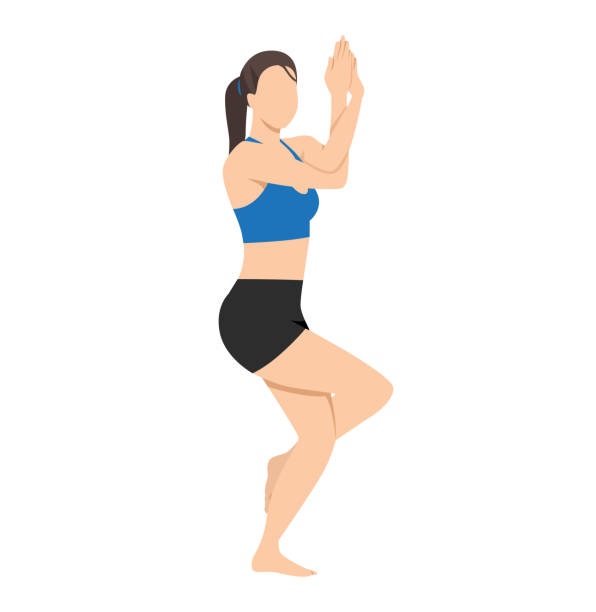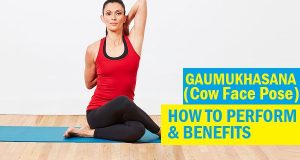
Garudasana (Eagle Pose): Benefits and Precautions
Garudasana, also known as Eagle Pose, is a yoga asana that embodies the grace and strength of an eagle. This pose offers a unique blend of balance, flexibility, and focus, making it a valuable addition to any yoga practice. In this article at Tips and Beauty Blog today, we will explore all about the Garudasana, like from the step-by-step execution, how to perform to its immense benefits. We will also highlight the precautions, its variations, and more. Let’s begin!
Garudasana: The Eagle Pose
Garudasana is a standing yoga pose that requires the intertwining of arms and legs, similar to an eagle wrapping its wings around its body. This pose engages both the upper and lower body, promoting balance, concentration, and flexibility.
Step-by-Step Guide to Master Garudasana
- Begin in a standing position with your feet together.
- Bend your knees slightly and lift your left foot off the floor.
- Cross your left thigh over your right thigh, hooking the top of your left foot behind your right calf.
- Extend both the arms forward at shoulder height.
- Cross your right arm over your left arm, bringing your palms to touch.
- Sink into a mini-squat as you press your palms away from your face.
- Focus your gaze on a fixed point to aid balance.
- Hold the pose for several breaths, then release and repeat on the other side.
Benefits of Garudasana (Eagle Pose)
Garudasana, or Eagle Pose, invites practitioners to intertwine one arm with the other and one leg with the other, creating a harmonious union of strength and balance. This asana not only challenges your physical boundaries but also encourages mental presence and awareness. Let’s explore the multitude of health benefits that this pose bestows upon those who practice it regularly.
Elevating Lung Capacity Through Deep Breathing
One of the unique attributes of Garudasana is its influence on your breath. The pose necessitates wrapping your arms in front of you, thereby expanding the back of your lungs. This expansion enhances your lung capacity, allowing you to breathe deeply and fully, nourishing your body with revitalizing oxygen.
Fostering Focus and Balance
Garudasana demands focused attention. As you balance on one leg and intertwine your arms, you’re prompted to set your gaze on a fixed point ahead. This deliberate focus not only enhances your physical balance but also serves as a meditative practice, grounding you in the present moment.
Deep Hip Stretching and Flexibility
It’s true that the Eagle Pose offers a profound stretch to the hips. By sitting back in a chair-like position and tightly wrapping your legs, you unlock the potential for deep hip stretching. The more you embrace this stretch, the greater the flexibility you’ll achieve in your hip joints.
Strengthening Leg Muscles and Enhancing Stability
While performing the pose’s chair-like position with crossed legs provides a unique strengthening effect on the leg muscles. As you engage and stabilize these muscles, your overall stability and balance receive a substantial boost.
Promoting Stabilization and Coordination
Garudasana’s emphasis on balance promotes stabilization and coordination. This aspect is especially valuable for individuals who face challenges in maintaining balance due to age or past injuries.
Cultivating Relaxation and Body Awareness
Beyond its physical benefits, Garudasana serves as a powerful tool for relaxation and body awareness. In fact, by holding the pose and directing your focus, you cultivate a deep sense of mindfulness and tranquility.
Alleviating Neck and Shoulder Discomfort
For those grappling with neck and shoulder discomfort, Garudasana presents a valuable solution. Actually, by stabilizing the neck and shoulders while holding the pose, it can alleviate stiffness and tension in these areas, providing relief from discomfort.
Enhancing Circulation and Joint Health
The act of twisting and stretching your arms and legs in Garudasana stimulates circulation throughout your body. Additionally, this dynamic movement helps prevent joint pains, cramps, and stiffness, promoting overall joint health.
Augmenting Flexibility for Daily Activities
The improved flexibility cultivated through regular practice of Garudasana actually contributes to the ease of daily activities. In other words, as your body becomes more supple, you’ll find movements and tasks in your daily routine more fluid and effortless. People who are obese and in their middle ages must try yoga poses for better movement and flexibility.
Managing Sciatica Through Eagle Pose
Garudasana can serve as an effective measure for managing sciatica. By gently lengthening the spine and minimizing compression on the sciatic nerve, practitioners can experience relief from radiating pain in the lower back, thighs, and calves.
Reducing Lower Back Pain and Stiffness
For individuals struggling with lower back pain and stiffness, Garudasana offers a soothing solution. The pose’s twisting and stretching actions contribute to enhanced spinal flexibility and relief from discomfort.
Nurturing Digestive Health
One of the lesser-known benefits of Garudasana is its positive impact on digestive health. The pose’s twisting motion gently massages the abdominal region, promoting healthy digestion and preventing digestive issues.
Also Explore:
Gomukhasana (Cow Face Pose) Benefits and How to Perform
Naukasana (Boat Pose) Benefits and How to Perform
Vajrasana (Thunderbolt Pose) Benefits and How to Perform
Bhujangasana (Cobra Pose) Benefits and How to Perform
Who Should Avoid Garudasana?
While Garudasana offers a wealth of benefits, there are specific groups of individuals who should exercise caution or avoid this pose altogether:
- Those recovering from recent shoulder, ankle, or knee injuries.
- Individuals dealing with obesity.
- People who experience frequent headaches.
- Those with high or low blood pressure.
- Individuals with inner ear problems.
- People managing asthma or COPD.
- Pregnant women in their third trimester.
- Individuals with fever, flu, or cold symptoms.
- People facing extreme stress or anxiety.
- Those recovering from recent surgery.
- Incorporating Garudasana into Your Routine
- Garudasana can be an excellent addition to your yoga routine:
- Include it after a thorough warm-up to ensure joint mobility.
- Practice regularly to gradually improve balance and flexibility.
- Connect with your breath to stay grounded and focused.
- Visualize the strength and poise of an eagle, embodying these qualities.
Variations of Garudasana (Eagle Pose)
Garudasana, also known as Eagle Pose, is a yoga posture that symbolizes grace and strength. This versatile pose offers not only its fundamental version but also exciting variations that provide unique benefits and challenges. In this article, we will delve into two intriguing variations of Garudasana: Garudasana Arms and Garudasana Twist. These variations add depth to your practice, promoting flexibility, balance, and enhanced mind-body connection.
Garudasana Arms: A Deeper Arm Stretch
Garudasana Arms is a variation that focuses on a deeper stretch for the arms and shoulders. In this variation, the arm binding is maintained while sitting in a comfortable position.
Step-by-Step Guide to Garudasana Arms
- Begin in a seated position with your spine erect.
- Extend your arms forward at shoulder height.
- Cross your right arm over your left arm, bringing your palms to touch.
- If possible, wrap your arms further by bringing your right hand to touch your left palm.
- Keep your spine straight and chest open as you hold the bind.
- Breathe deeply and hold the position for several breaths, then switch sides.
Benefits of Garudasana Arms
Shoulder and Upper Body Stretch: The arm binding in this variation provides a more intense stretch to the shoulders, upper back, and arms.
Enhanced Mobility: Garudasana Arms improves the range of motion in the shoulder joints, promoting better flexibility and mobility.
Release of Tension: The variation helps release tension and stiffness in the shoulders and upper back.
Garudasana Twist
Garudasana Twist is a playful variation that combines the twisting action of Garudasana with a deeper spinal twist.
Step-by-Step Guide to Garudasana Twist
- Begin in a comfortable standing position.
- Cross your right thigh over your left thigh, hooking your right foot behind your left calf.
- Extend your arms forward at shoulder height.
- Cross your right arm over your left arm, bringing your palms to touch.
- Inhale as you lengthen your spine, and exhale as you twist your torso to the right.
- Hook your left elbow over your right thigh, deepening the twist.
- Maintain the twist as you continue to breathe deeply.
- Slowly release and switch sides to repeat the twist on the opposite direction.
Advantages of Garudasana Twist
Spinal Mobility: The twisting motion in this variation enhances the flexibility and mobility of the spine.
Strengthened Core: The engagement of the core muscles supports the twisting movement, promoting a stronger core.
Balancing Act: Garudasana Twist challenges your balance, requiring concentration and stability.
Exploring Garudasana Variations allows you to get the essence of the pose in diverse ways. Additionally, from the invigorating stretch of Garudasana Arms to the balancing act of Garudasana Twist, these variations actually open a world of exploration and growth. As you integrate these variations into your practice, undoubtedly, you unveil new layers of flexibility, balance, and connection.
Garudasana Extra Tips and Benefits
- Inhale deeply to create space in the body.
- Exhale as you deepen the pose or twist, allowing for a more profound stretch.
- Focus on the alignment of the legs and arms in the foundational pose.
- Once you feel comfortable, explore the variations to expand your practice.
- Approach the variations with curiosity and a willingness to explore.
- Embrace any wobbles or challenges as part of the journey.
- Tune into the sensations in your body as you enter each variation.
- Allow the practice to cultivate presence and awareness.
- Embrace the sensation of balance and allow it to center your mind.
- Let go of distractions as you hold the pose, fostering mental focus.
FAQs About Garudasana
Q: Is Garudasana suitable for beginners?
A: Yes, beginners can practice Garudasana with modifications and gradually progress.
Q: Can Garudasana help with improving posture?
A: Yes, the pose encourages an upright posture by strengthening the back muscles.
Q: How long should I hold Garudasana?
A: Aim for 20-30 seconds on each side, gradually increasing the duration.
Q: Can Garudasana relieve tension in the shoulders?
A: Yes, the pose stretches and releases tension in the upper back and shoulders.
Q: Can I practice Garudasana if I have balance issues?
A: Yes, practicing Garudasana can improve balance over time. Start near a wall for support if needed.
Q: Are Garudasana Variations suitable for beginners?
A: Beginners can explore these variations with modifications and guidance from a yoga instructor.
Q: Can Garudasana Variations relieve back pain?
A: These variations can promote spinal flexibility, which may alleviate mild back discomfort.
Q: Are the variations safe for individuals with shoulder issues?
A: It’s advisable to consult a healthcare professional before attempting variations if you have shoulder concerns.
Q: How long should I hold each variation?
A: Aim for 20-30 seconds on each side, gradually increasing the duration as your flexibility improves.
Q: Can I incorporate these variations into my daily practice?
A: Yes, including Garudasana Variations in your routine can add depth and diversity to your practice.
Now that we have explained above, Garudasana, the Eagle Pose, offers a powerful metaphor for balance and strength, drawing inspiration from the majestic eagle. Furthermore, as you weave your arms and legs into this intricate pose, you align your body and mind, fostering both physical and mental well-being. Whether you’re seeking improved balance, flexibility, or concentration. Garudasana, indeed has array of benefits, with which once can soar to new heights of physical and mental health.
 Tips and Beauty Site about Skin care, Hair care, Health, weight loss and lifestyle tips
Tips and Beauty Site about Skin care, Hair care, Health, weight loss and lifestyle tips







